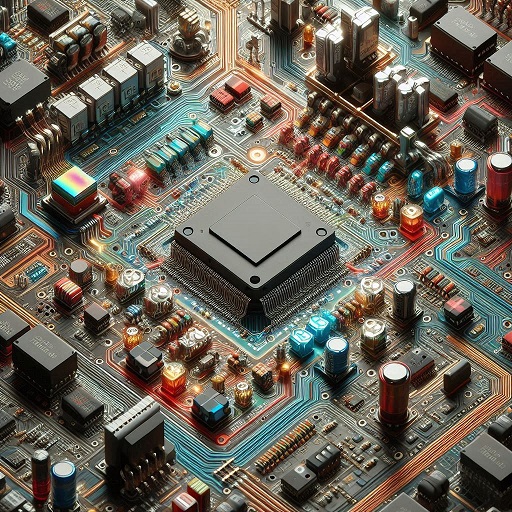Field-Programmable Gate Arrays (FPGAs) have revolutionized the consumer electronics industry by offering a flexible, reconfigurable solution for the design and development of various electronic devices. From smartphones and gaming consoles to smart home systems, FPGAs are playing an increasingly important role in delivering customized, high-performance, and energy-efficient solutions. This article explores the profound impact of FPGA in consumer electronics, providing insights into its benefits, challenges, and future potential.

The Basics of FPGA Technology
FPGAs, or Field-Programmable Gate Arrays, are semiconductor devices that can be programmed or configured after manufacturing to perform a wide range of tasks. Unlike traditional Application-Specific Integrated Circuits (ASICs), which are designed for specific tasks, FPGAs can be reprogrammed multiple times to suit different applications.
At the core of an FPGA lies an array of programmable logic blocks, interconnected via programmable routing channels. This unique structure enables engineers to customize the device’s functionality to suit specific needs, making FPGAs a highly versatile solution for consumer electronics.
FPGA Market Overview
The Field Programmable Gate Array (FPGA) market size was valued at USD 12.1 billion in 2024 and is projected to reach USD 25.8 billion by 2029, registering a CAGR of 16.4% during the forecast period.
Download PDF Brochure @ https://www.marketsandmarkets.com/pdfdownloadNew.asp?id=194123367
Driving Factors for Market Growth
Several factors are contributing to the growth of the FPGA market. One key driver is the increasing integration of FPGAs in advanced driver assistance systems (ADAS). These systems benefit from hardware acceleration and real-time processing capabilities provided by FPGAs.
Adoption in Data Centers and High-Performance Computing
Another significant factor is the growing use of FPGAs in data centers and high-performance computing applications. The ability of FPGAs to enhance processing efficiency makes them ideal for these demanding environments.
Key Components of FPGAs in Electronics
FPGAs consist of key components like:
- Configurable Logic Blocks (CLBs)
- Input/Output Blocks (IOBs)
- Interconnects and switches These components work together to execute complex digital computations and tasks.
Applications of FPGA in Consumer Electronics
FPGAs have found their way into numerous consumer applications due to their flexibility and performance. In smartphones, FPGAs help enhance data processing, video playback, and power efficiency, leading to better user experiences.
Smartphones and Mobile Devices
In modern smartphones, FPGAs can process data faster and enable real-time adjustments to the phone’s configuration. From enhancing image processing to improving data compression, FPGAs bring new levels of functionality and performance to mobile devices.
Home Automation Systems
FPGAs also support smart home automation devices, enabling real-time monitoring and control functions in smart thermostats, lighting systems, and security solutions. Their adaptability allows for seamless upgrades and system reconfigurations, keeping these devices up-to-date with emerging technologies.
Gaming Consoles and Entertainment Systems
The high computational power of FPGAs makes them ideal for gaming consoles, delivering improved graphics rendering and faster processing speeds for immersive gaming experiences. FPGAs also support the integration of augmented reality (AR) and virtual reality (VR) in gaming platforms.
Benefits of FPGAs in Consumer Devices
FPGAs offer multiple advantages in consumer electronics, from customization to enhanced energy efficiency.
Customization and Adaptability
One of the greatest strengths of FPGAs is their reconfigurability. This adaptability allows developers to fine-tune devices post-production, adding new features or upgrading existing ones without replacing the hardware.
Energy Efficiency
FPGAs consume less power compared to conventional processors, which is especially beneficial for battery-operated devices. Their ability to switch off unused blocks reduces energy consumption, making them ideal for power-sensitive applications.
Cost-Effectiveness
Although FPGAs can be more expensive to develop initially, their long-term benefits include reduced development costs as the same device can be repurposed for various applications.
FPGA and IoT: A Perfect Pair
The integration of FPGAs in the Internet of Things (IoT) is another area where their flexibility shines. FPGAs provide the processing power needed to handle vast amounts of data generated by IoT devices while maintaining low latency and high performance.
IoT Gateways Powered by FPGAs
IoT gateways serve as the central hub for connecting various smart devices, and FPGAs enhance these gateways by providing efficient data processing and enabling real-time communication between devices.
Performance Advantages of FPGA in Consumer Electronics
Speed and Parallel Processing
FPGAs offer superior parallel processing capabilities, allowing them to perform multiple tasks simultaneously. This results in faster data processing speeds, particularly in multimedia applications like video streaming or image processing.
Enhanced Data Throughput
FPGA technology can handle large data volumes efficiently, making it ideal for high-definition video streaming, gaming, and other data-intensive consumer applications.
FAQs
- What is an FPGA in consumer electronics? An FPGA is a reconfigurable semiconductor device used in consumer electronics to provide flexibility and high performance, enabling real-time customization of tasks and features.
- Why are FPGAs preferred over ASICs in some devices? FPGAs are preferred for their adaptability and lower initial development costs, making them suitable for devices that require frequent updates or feature expansions.
- How do FPGAs improve energy efficiency? FPGAs reduce energy consumption by powering down unused sections of the device, making them more efficient for battery-powered applications.
- Can FPGAs be used in smart home systems? Yes, FPGAs are commonly used in smart home systems to enable real-time monitoring and efficient control of home automation devices.
- Are FPGAs used in wearable technology? FPGAs are utilized in wearable technology, especially in health monitoring and AR devices, to provide advanced processing capabilities.
- What is the future of FPGAs in consumer electronics? The future of FPGAs in consumer electronics includes greater integration with AI and 5G technologies, offering even more powerful and flexible devices.
